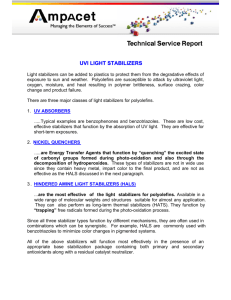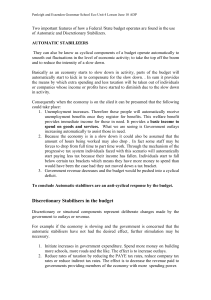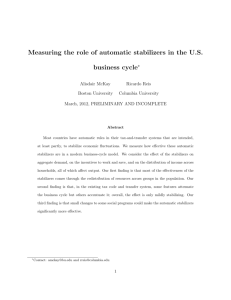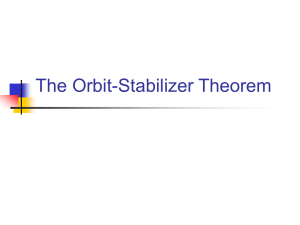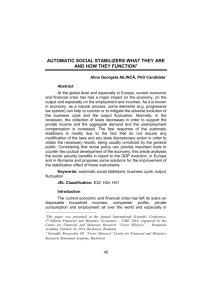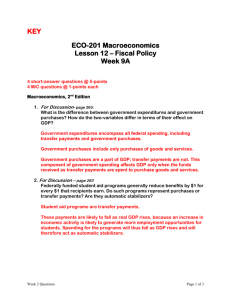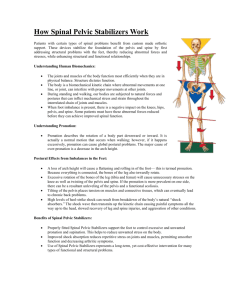Effectiveness of Automatic Stabilizers
advertisement
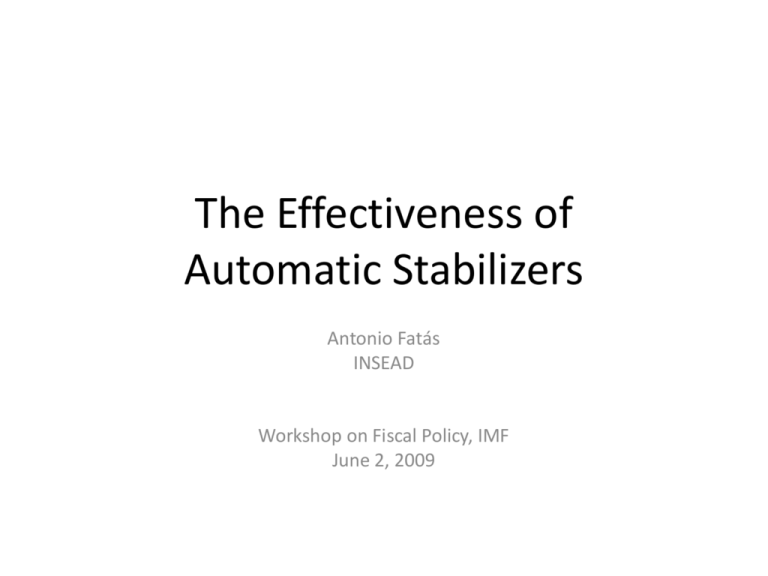
The Effectiveness of Automatic Stabilizers Antonio Fatás INSEAD Workshop on Fiscal Policy, IMF June 2, 2009 Automatic Stabilizers • “Quietly and modestly doing their thing”, Cohen and Follette (1999). • But what is “their thing”? • “In the last 10 years automatic stabilizers have not been discussed much by academics”, Blanchard (1999). • “Very little work has been done on automatic stabilization. JSTOR lists only 11 articles in the last 20 years”, Blanchard (2004). • Limited (academic) interest was partly due to the assumption that fiscal policy was not a good stabilizing tool. But this perspective has now changed (maybe it is still not “good” but we are heavily relying on it) 1 Defining Automatic Stabilizers • Changes in government revenues or expenditures due to changes in the cyclical stance of the economy • They help stabilize business cycles • They are automatically triggered by the tax code or spending rules (i.e. they do not require any discretion on the part of governments) • Examples: taxes as a function of income, unemployment benefits • It is difficult to produce an “absolute” definition of automatic stabilizers but we can always compare alternative systems (across countries or time) 2 Defining Automatic Stabilizers • The size and effectiveness of automatic stabilizers has to be measured in reference to outcomes and not so much to the (cyclical) behavior of the fiscal variables. • Within the same budget category, the two are related: Taxes that are a function of income (even if they are proportional to income) stabilize income more than taxes that are fixed (income taxes versus property taxes). • But across categories, it is less obvious: It can be that a fiscal variable that is acyclical (such as government wages) produces a stabilizing effect on GDP that is larger than one that is countercyclical (income taxes). 3 Measuring Automatic Stabilizers • Starting point is to measure the cyclical elasticity of different budget components. • Typically 5 components are considered (OECD): – – – – – Income tax Social security contributions Corporate tax Indirect taxes Unemployment benefits 4 Measuring Automatic Stabilizers • Two methods to measure the cyclicality of fiscal variables 1. Regression-based analysis of how taxes or spending react to the business cycle. Problem of: • Endogeneity • Impossibility of separating discretionary actions from automatic stabilizers • Results can be highly dependant on the cyclical indicator or specification used. 5 Measuring Automatic Stabilizers 2. Estimate the elasticity of the tax base to changes in the cycle (regression based) and combine it with information from the tax code on how taxes change when the tax base changes. Example from Andre and Girouard (2005) Where the elasticity of tax income per worker is calculated as a ratio of the marginal to average tax rate. Problems: – Time-varying elasticities – Estimates of cyclicality of tax bases – Composition effects 6 Measuring Automatic Stabilizers • Semi-elasticity of budget balance (as % of GDP) for a 1% change in GDP. Andre and Girouard (2005) 0.7 0.6 0.5 0.4 0.3 0.2 0.1 0 1996 2000 2003 7 Measuring Automatic Stabilizers • There are large differences across countries. • On average (for OECD economies) the budget balance as % of GDP changes by 0.48 percentage points when GDP changes by 1%. • The estimates range from a low 0.2 (Korea) to a high of 0.6 (Denmark or Sweden). 8 Measuring Automatic Stabilizers • Measures of automatic stabilizers are highly correlated with government size (and to some extent this is a scale effect) Source: Andre and Girouard (2005) 9 Effectiveness of Automatic Stabilizers • Taxes and transfers can smooth disposable income and help stabilize consumption under the assumption that Ricardian Equivalence does not hold. • Measuring these effects is subject to the same problems as measuring the effects of discretionary fiscal policy. • Regression-based analysis of the stabilizing role of taxes and transfers shows small effects (Arreaza, Sorensen and Yosha (1998); Melitz (2005)). But they only capture the stabilizing effects on income, which is small as taxes are not that progressive. 10 Effectiveness of Automatic Stabilizers • But stabilization is not just about disposable income but income (GDP) itself and government expenditures and government consumption can play a strong role. But measuring this effect is even more difficult because of endogeneity and the difficulty in identifying shocks. • This problem is not that different from the one we face when measuring the effect of discretionary policy, especially when discretion is in response to output shocks (endogenous discretionary fiscal policy). 11 Effectiveness of Automatic Stabilizers 1. Using simulations based on macromodels (average effect around 25%). Source: Van den Noord (2000) 12 Effectiveness of Automatic Stabilizers 2. Exploring cross-sectional differences in degree of automatic stabilizers. a) Using semi-elasticity budget balance. 3.9 Output Volatility 3.4 2.9 2.4 1.9 1.4 0.9 0.15 0.2 0.25 0.3 0.35 0.4 0.45 0.5 0.55 0.6 Automatic Stabilizers measured by the Semi-elasticity overall budget balance Data: 22 OECD countries, volatility measured as standard deviation output growth 1960-2008 13 Effectiveness of Automatic Stabilizers 2. Exploring cross-sectional differences in degree of automatic stabilizers. b) Using Government Size (expenditures as % of GDP). 3.9 Output Volatility 3.4 2.9 2.4 1.9 1.4 0.9 12 17 22 27 32 37 42 47 52 Automatic Stabilizers measured by Government Size Data: 22 OECD countries, volatility measured as standard deviation output growth 1960-2008 14 Effectiveness of Automatic Stabilizers Stabilizing effects are present in many macroeconomic variables: output (y), consumption (c), wages (w) and investment (e). Source: Andrés, Domenech and Fatás (2008) 15 There is no clear pattern when it comes to different components of the budget (spending, revenues, transfers) Results are robust to inclusion of standard determinants of volatility and use of instrumental variables Stabilizing effects also present for a sample of US States Source: Fatás and Mihov (2001) 16 Effectiveness of Automatic Stabilizers • The relationship between government size and volatility is stronger (both from a statistical and economic point of view) for developed countries. Volatility (GDP growth) and government size Coefficient on G/Y GDP per capita (2007) cutoff Number of countries -2.41 (-3.07) > 20,000 26 -2.18 (-3.41) -1.56 (-2.65) -1.12 (-2.19) > 10,000 > 5,000 > 2,000 37 53 82 -0.04 (-0.10) none 139 WDI data. 1970-2007. GDP per capita included in al regressions. 17 Effectiveness of Automatic Stabilizers • Are the size of these effects reasonable? • A decrease in government size from 40% to 30% increases the volatility of output by about 25%, this is similar to the estimated effects of completely eliminating automatic stabilizers in macromodels –e.g. van der Noord (2000). • Effectiveness of automatic stabilizers seem to be much larger when looking at government size. Why? The exercise is a very different one. Making taxes and transfers acyclical is very different from making the size of the government = 0. A large government where spending is simply constant and taxes are not countercyclical will still induce stabilizing effects on GDP. 18 Effectiveness of Automatic Stabilizers • Some theory (from Andrés, Domenech and Fatás (2008)): – New Keynesian model with nominal rigidities and costs of adjustment of investment – A larger government stabilizes GDP and the stabilizing effect increases with the degree of rigidities – But Consumption and Investment are more volatile with a larger government – the only reason why GDP is more stable is because of the stability of government spending – Introducing rule-of-thumb consumers generates a stabilizing effect of government size on consumption and allows us to replicate the empirical results 19 Effectiveness of Automatic Stabilizers • Another way to look at the estimates of automatic stabilizers is to use the semi-elasticities of budget balances and estimate their stabilizing effect using multipliers from the literature on the effects of discretionary changes in fiscal policy. • Warning: this does not even qualify as a “back of the envelope calculation” 20 Effectiveness of Automatic Stabilizers 3.9 Output Volatility 3.4 2.9 2.4 1.9 1.4 0.9 0.15 0.2 0.25 0.3 0.35 0.4 0.45 0.5 0.55 0.6 Automatic Stabilizers measured by the Semi-elasticity overall budget balance Data: 22 OECD countries, volatility measured as standard deviation output growth 1960-2008 21 Effectiveness of Automatic Stabilizers • Take the two extremes in terms of the estimates of the semi-elasticity of budget balance : 0.22 (Korea) and 0.59 (Denmark). • Think about the difference as a discretionary change in fiscal policy (in Denmark) of about 0.37 for every 1% drop in output. • Assume the discretionary change in the budget has a multiplier of 1.3. After some strong (and questionable) assumptions we conclude that volatility of GDP in Denmark should be lower than in Korea by about 48%. In the chart, volatility is reduced by about 60%. To get this result we would need a multiplier of about 1.6. 22 Effectiveness of Automatic Stabilizers • The effect of automatic stabilizers shown in the cross-country analysis is not far from some of the recently estimated fiscal policy multipliers. • Automatic stabilizers could theoretically generate larger multipliers because: – They are endogenous, they take place at the right time (stimulus takes place when there are idle resources) – They are anticipated – They are temporary (no concern about long-term sustainability) 23 Effectiveness of Automatic Stabilizers • There is evidence that the effectiveness of fiscal policy multipliers has gone down over time. • The relationship between government size and volatility has become weaker (Debrun, Pisany-Ferry and Sapir, 2008). • This evidence also matches two other observations: – Government size has decreased in some countries. – Estimated elasticities (OECD) have decreased (see previous slides) 24 Effectiveness of Automatic Stabilizers From Debrun, Pisany-Ferry and Sapir (2008) 25 Effectiveness of Automatic Stabilizers • Why are automatic stabilizers getting weaker? Some potential explanations – Small sample dominated by the Great Moderation, not enough variability in business cycles (the Euro area has not seen a recession in that period). – There is some evidence that fiscal policy multipliers are becoming smaller (although this is not well understood either) – Monetary Policy or fiscal policy discretion have compensated for the lack of automatic stabilizers. There is empirical evidence that this is the case. 26 Automatic Stabilizers and Discretionary Fiscal Policy • Is fiscal policy discretion becoming a substitute for automatic stabilizers? • We construct a measure of how countercyclical discretionary fiscal policy was by regressing the cyclicallyadjusted balance on GDP growth during the period 19902008. • We want to see if there is a negative correlation with the degree of automatic stabilizers as measured by the semielasticity of the budget balance (OECD calculations). • Correlation is negative. In countries with low level of automatic stabilizers, discretionary fiscal policy has stepped in and compensated for their absence. 27 Automatic Stabilizers and Discretionary Fiscal Policy Countercyclicality of Discretionary Fiscal Policy (1990-2008) 1.6 GRE 1.4 JAP 1.2 CAN 1 USA 0.8 0.6 0.4 0.2 0 0.3 -0.2 -0.4 0.35 0.4 0.45 0.5 0.55 DEN 0.6 AUT Automatic Stabilizers measured as semi-elasticity of budget balance 28 Automatic Stabilizers and Discretionary Fiscal Policy In response to the current crisis discretionary fiscal policy has also compensated for the lack of automatic stabilizers Source: OECD 2009 29 Discretionary fiscal policy or automatic stabilizers? • Evidence shown suggests that automatic stabilizers are more effective. This should not be a surprise (timely, targeted, temporary, anticipated). • In addition, discretionary fiscal policy is subject to political interference and lags of implementation. There is evidence that discretionary fiscal policy generates unnecessary volatility and harm long-term growth (Fatás and Mihov (2003)) • It could also be that the use of discretionary fiscal policy leads to problems of long-term sustainability because of asymmetries. 30 Discretionary fiscal policy or automatic stabilizers? • One concern with automatic stabilizers is that they might come with a price: trade off with efficiency? • Also, can we design them to take care of every circumstance? Probably not, but is it that different from the implementation issues associated to the current fiscal stimulus packages? • Automatic stabilizers are today the by-product of decisions based in political goals, can we design stabilizers which are strictly dealing with business cycles? 31 Automatic Stabilizers • Automatic stabilizers are a by-product of political decisions regarding political goals (such as redistribution) Source: OECD (2009) 32 Discretionary fiscal policy or automatic stabilizers? • At the end the debate depends on our views on the quality of fiscal policy institutions. If we trust governments to use discretion optimally (and act quickly during recessions), the additional flexibility to adapt their actions to the specific shocks that are hitting the economy makes discretion superior to automatic stabilizers. • But if there are implementation lags or we simply do not trust government to produce optimal responses to recessions, then automatic stabilizers dominate. 33 Conclusions • Automatic stabilizers are (not so) quietly doing their thing (stabilize GDP, income and consumption) • They complement other stabilization policies: monetary policy, discretionary fiscal policy • Our knowledge of how automatic stabilizers operate is quite limited (yes, we need to write more papers on this subject) – Elasticities are not constant – Large composition effects – Excessive reliance on output gap as a cyclical indicator (evidence that actual budget balances are much more reactive to output growth than to standard measures of the output gap) 34

